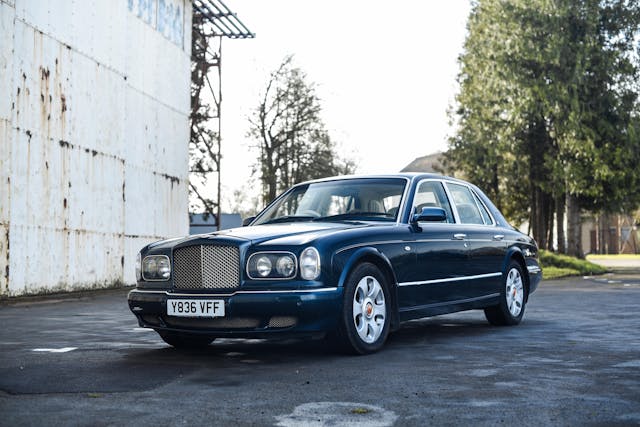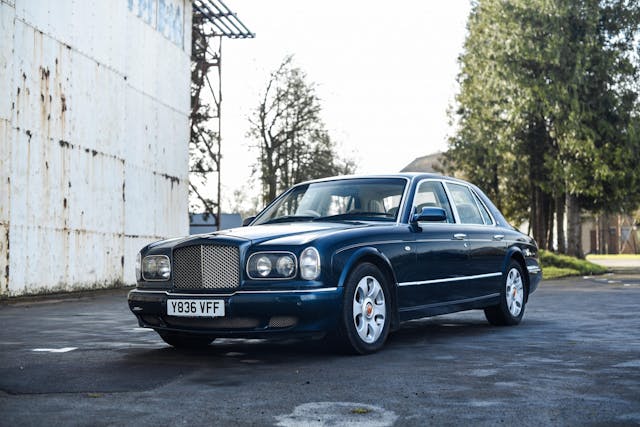Media | Articles
Why do 1990s–2000s British luxury machines depreciate so much?
British luxury cars have a certain reputation for depreciation. Still, the prospect of an Aston Martin, a Rolls-Royce, or a Bentley for 85 percent below MSRP can be tempting. Even now, I am stealthily opening an eBay tab “just to look.” Surely I am not alone in this affliction, but then, why do so few people pull the trigger and buy these cars? High-end Brits depreciate heavily for a reason, but once they have, are they worth the discount? For context, let’s investigate examples at the upcoming Bonhams May Motoring auction.
1999 Aston Martin DB7

Bonhams’ estimate: $28,000–$35,000
Aston’s DB7 may not have been a Bond car, but it was a big deal for the British brand during a critical stage in the marque’s life. The 1999 DB7 on offer here, like the 2005 DB9 we’ll get to in a bit, provides the most affordable entry point for Aston ownership.
The success of the DB7 played a major part in propping up Aston Martin’s business in the 1990s, during a time when company parent Ford had moved the marque away from old-school coachbuilding and toward higher-volume manufacturing. Early DB7s, built from 1994–1998, came with a supercharged inline-six. 1999 and later Vantage models brought the more desirable V-12, but the big feature buyers look for is the manual transmission, which represents a 25-percent price premium.
The Vantage on offer at Bonhams is of the V-12 six-speed variety, with an estimate of $27,000–$34,000. (For context, according to our data, a #3-condition example is worth $33,300.) Adjusted for inflation, that’s a roughly 85-percent decrease from the car’s $145,000 MSRP ($198,000 in 2020 dollars). The Bonhams example has 60,000 miles—high for a DB7—but it shows well with few visible flaws.
Looking at Hagerty Price Guide history, the #1-condition (Concours) value for the DB7 has dropped 4.5 percent in last two years, while the #3-condition (Good) value dropped a considerable 17 percent. This tells me a couple things: First, the model is still depreciating, but perfect examples are holding value. Second, buyers are likely scared away by higher-mile cars or ones that need work. After all, you’re often better off spending more for a better car than saving money up front and buying a “driver.”
Marketplace
Buy and sell classics with confidence
2005 Aston Martin DB9

Bonhams’ estimate: $31,000–$38,000
The DB9 arrived for 2004, following the retirement of the DB7, and was a significant improvement over its predecessor. Designed by Henrik Fisker and Ian Callum (the latter also penned the DB7), the DB9 was an essential chess piece for Aston’s grand sales ambitions. This is the car that set the stage for the marque’s development over the last two decades.
Converted to 2020 dollars, the DB9’s MSRP is a whopping $205,000. This example carries an estimate of $31,000–$37,000. That’s another decrease of around 85 percent. Mileage isn’t listed and Bonhams has not posted much other information, but the car appears to be in excellent shape. Over the last year, DB9s sold at auction have averaged $49,960—17 percent lower than the $59,880 average from the 12 months prior.
2001 Bentley Arnage Red Label

Bonhams’ estimate: $18,000–$23,000
Bentleys have long represented luxury, status, and fashion all wrapped up together. That vibe held when Volkswagen took over the brand in 1998, and this Arnage Red Label is a classy sedan indeed.
In modern dollars, the Arnage Red Label cost $306,000 when new. The car sports a curb weight of nearly three tons, a scale-tipping mass more than a little due to the hulking sedan’s prodigious amount of leather, metal, and real wood. When you sit it in an Arnage, it feels immense and solid. The doors swing like wrecking balls and fall shut with authority. This Bonhams example, with under 50,000 miles, presents very well and carries an estimate of only $17,000–$22,000, an astonishing 93-percent discount over inflation-adjusted MSRP. Arnages were often used as daily drivers or chauffeur cars, so higher mileage is not uncommon.
Auction sales show values holding steady: $33,800 on average over the last year, versus $32,800 the year before. The tight spread between these results, and relatively low values, indicate little speculative collector buying or mothballing. Most examples of the model appear to be regularly driven.
2004 Bentley Continental GT

Bonhams’ estimate: $19,000–$25,000
The Continental GT, the first mass-produced Bentley, debuted in 2003. It paved the way for the marque’s current success and propelled the brand to more than 7000 vehicles sold in 2004, versus some 800 in 2003. (Bentley sold 12,430 cars in 2019, 6653 of them Continental GTs.) The model is a true grand-touring 2+2, capable of nearly 200 mph, and it remains a regular sight in well-to-do neighborhoods. This 2004 example has 71,000 miles, which might seem a tad high, but like the Arnage, Continental GTs are often used as daily drivers. This one appears in #3 condition (Good) with some wear on bolsters and carpets. Adjusted for inflation, its MSRP works out to $204,000, which makes the estimate of $19,000–$25,000 an 89-percent decrease.
Continental GT values have dropped 18 percent over the last two years; that said, the last Hagerty Price Guide update was the first where the model’s values did not decrease. Public sales indicate that GTs continue to depreciate, with a 19-percent decrease in average transaction price from early 2018 to today’s $48,000 average.
Why they’re so cheap
We’ve discussed four British luxury cars here, all expected to sell for about $30,000, and all around 85–93 percent cheaper than when new. Let’s weigh the cost/benefits of such a purchase and try to better understand the considerable depreciation here.
MSRP math can be fun for comparison, but it ultimately doesn’t matter. Present-day value is what counts here—a car that was 200 grand when new is not worth that much now. If you consider cars of the same era, a $30,000 Aston or Bentley represents different value than, say, a near-perfect Honda S2000 or Corvette at the same price.
Of course, the driving experience of a Chevy or Honda isn’t comparable to what you get from an Aston Martin or a Bentley. And to be fair, it wasn’t designed to be. When properly sorted, high-end British cars of this nature are both comfortable and refined, and they can offer supreme rewards behind the wheel. This is balanced by the thorny issue of repair expenses: You might get a car for 85 percent off sticker, but repair bills won’t arrive with the same discount. On machines of this ilk, even a minor malady can be frighteningly expensive. Repair costs for a blown head gasket can total as much as $15,000. The convertible-top hydraulics on the Bentley Azure are a weak spot and can cost north of $10,000 to repair. Now imagine the cost of a head gasket or top on an S2000. For $15,000, you could simply buy a second S2000.
That idea of a ticking time bomb—one of unknown strength and with an unknown length of fuse—is what suppresses values of high-end British metal. Some own these cars for tens of thousands of miles and replace nothing but wiper blades. Others, not so lucky, find themselves saddled with repair bills higher than the car’s value. As always, maintenance records are paramount for any considered purchase, and buying from the original owner is a big bonus. If that person could afford the car when new, they could likely afford the necessary service and repair costs as it aged. The same can’t be said for the individual who bought the machine cheap and used and now wants out.
If you’re looking to jump into an older Aston, Bentley, or even a Rolls, the temptation is understandable. Just remember that, unless you’re lucky, the cheapest Bentley is always the most expensive one. It’s your choice on how much of a gamble to take.





